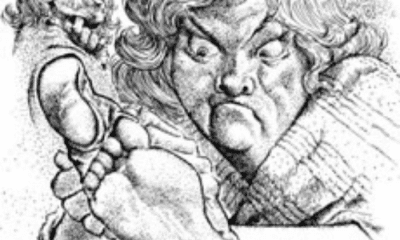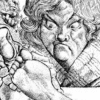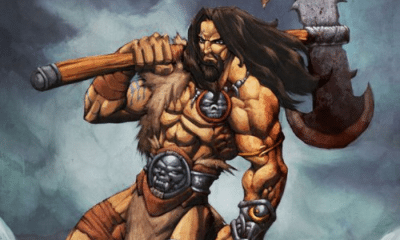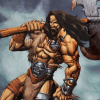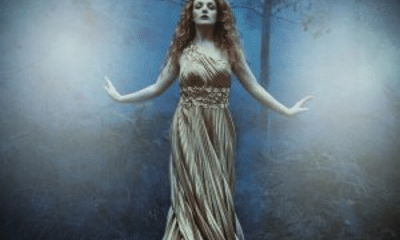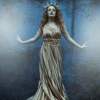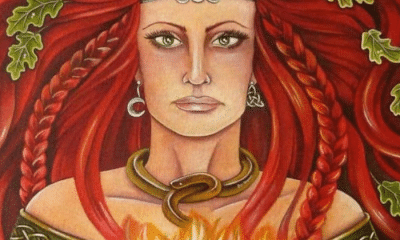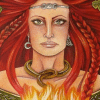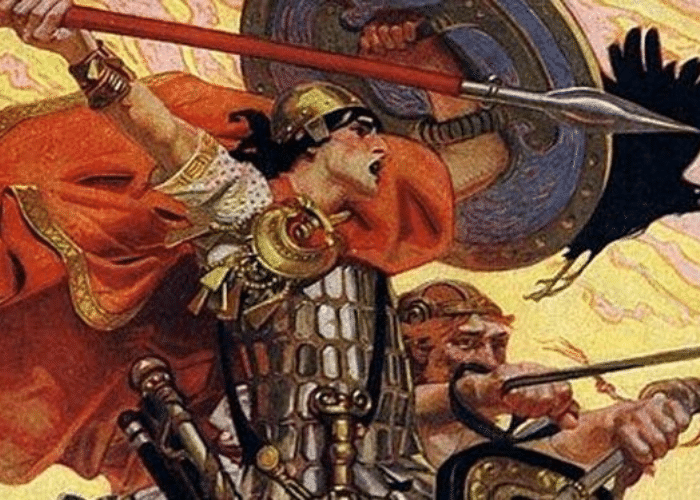
Irish
Neit: The Celtic God of War
Neit: The Celtic God of War
Neit was the god of war in Irish mythology, but he was killed before his people won their decisive battle.
In the mythology of Ireland, Neit, whose name is also sometimes spelled Net or Neith, was a god of war. He was one of the Tuatha Dé Dannan, the last group of supernatural men to invade the Emerald Isle.
The Tuatha Dé Dannan, largely regarded as the ancestral gods of the Irish people, are gods of Celtic culture. They arrived in the Iron Age with settlers from continental Europe and most, like Neit, have obvious ties to other European religions.
These Celtic gods, however, often do not survive the battles between the Tuatha Dé Dannan and Ireland’s earlier inhabitants. Their greatest legacy is not their own power, but the children they left behind from blended families.
Neit was a Celtic god, but his mythology helps to illustrate the fact that Ireland was not a purely Celtic land. The Gaelic culture of Ireland blended Celtic and indigenous influences that are reflected in their legends.
Neit and the Wars of the Gods
In Irish mythology, Neit was a powerful god of war.
No stories remain of Neit’s birth and family. Even his original affiliation is unclear because he had relationships with many figures from opposing groups in Irish mythology.
The first group to settle Ireland, according to some accounts, were the Fomorians. They were relatively weak and made a rough living off hunting, however, and for many years provided no resistance to later settlers who could till the land.
Nemed arrived next with his followers. They demanded a heavy tribute from the Fomorians.
The Fomorians drove Nemed’s people from Ireland, killing all but thirty of them. For the first time, they had true power.
They remained isolated, however, so when the Fir Bolg arrived the two groups did not meet.
Finally, the Tuatha Dé Dannan, descendants of Nemed’s surviving people, arrived in Ireland. The most well-known of the island’s supernatural ancestors, the Tuatha Dé Dannan are generally regarded as the Irish people’s gods.
Neit had ties to many of these mythological groups, and his shifting allegiances would form a major part of his mythology.
When the Tuatha Dé Dannan defeated the Fir Bolg, they became enemies of the Fomorians. Despite this, however, some intermarried.
Neit was the uncle of the Dagda, one of the most powerful leaders of the Tuatha Dé Dannan. At least one of his sons, however, was a prominent Fomorian.
This is not because he married a Fomorian woman. Neit was the husband of either the Babd or Nemain, possibly both, who were both parts of the triple-goddess the Morrigan.
It seems possible, therefore, that both Neit and the Dagda’s father, his brother, were born among the Fomorians. If that was the case, Neit shifted his allegiances and joined the Tuatha Dé Dannan with his wife and nephew.
Cath Tánaiste Maige Tuired, Anglicized as the Second Battle of Mag Tuired or Moytura, was the deciding battle in the long struggle between the Fomorians and the Tuatha Dé Dannan. The Fomorians had won control of Ireland and oppressed the newcomers, and this battle was the last opportunity for the Tuatha Dé Dannan to claim the land.
While under the control of the Fomorians, the Tuatha Dé Dannan had been ruled by one of Neit’s relatives, wither a grandson or a nephew, called Bres. Because he was loyal to his Fomorian father’s people, Bres oppressed the Tuatha Dé Dannan including, presumably, his relatives among them.
When Nuada regained kingship over the Tuatha Dé Dannan and was joined by Lugh, another half-Fomorian, Bres begged his father, the Fomorian king Elatha for aid. Elatha refused but Balor of the Evil Eye, Neit’s grandson, agreed to command his army.
The two sides met at Mag Tuired in a bloody clash of both physical power and magic. Leaders on both sides were killed, with Nuada falling in battle and Lugh taking down Balor of the Evil Eye.
Neit, too, was said to have fallen in the conflict. The god of war died but his chosen people, with the help of his equally war-like wife, were able to prevail.
My Modern Interpretation
Irish mythology is often interpreted as being the product of many waves of immigration to the Emerald Isle. Each successive supernatural group is thought to represent a different culture that inhabited Ireland in prehistory.
The complex family relationships and allegiances of many mythological figures become easier to understand if this interpretation is correct.
Historians who follow this theory believe that the Fomorians were among Ireland’s earliest inhabitants. Although the medieval monks who first recorded the legends likened them to Viking invaders, they were hunter-gatherers who predated the Celtic culture.
The Tuatha Dé Dannan were the gods and leaders of the Celts who arrived during the Iron Age. The Celts did not invade suddenly, however, but moved into Ireland over the course of several centuries.
There may have been conflicts, such as the battles of Mag Tuired, between the different cultures of Ireland at the time, but their myths also show that the Celts and the indigenous people intermixed to eventually create Gaelic culture.
DNA testing has given additional credence to the idea that the Irish people are not purely Celtic. Irish people often show Y-DNA markers, inherited through the male line, that reflect both Celtic and non-Celtic ancestry, proving that the earliest inhabitants of the island were not completely vanquished by the Celts.
As a result, many of their mythological figures were mixed, as well. As gods were conflated and human leaders were born of mixed parentage, the legends of Ireland increasingly included characters that matched the country’s ancient people.
In this theory, the Fomorians are generally interpreted as the gods of the pre-Celtic people. They are often said to represent the primal forces that would have been worshipped by a more primitive civilization, while the Tuatha Dé Dannan show the values and culture of the Celts.
In the case of Neit, there is significant evidence that he was a war god brought to Ireland by the Celts.
Other Celtic cultures in Europe worshipped a war god called Neto, who has a very similar name and function. The Romans referred to him as Mars Neto, linking him to their own god of warfare, and also associated him with the radiant and multi-talented Apollo.
Neit, however, shows a common theme in Irish mythology. The gods with strictly Celtic origins are often killed as the Tuatha Dé Dannan vie for power.
If the theory that Irish mythology is an allegory for the country’s history, such deaths can be seen as symbolic of the island’s mixed heritage. The culture did not survive as purely Celtic, but as a Gaelic mix of influences.
Gods like Neit who came from a strong continental tradition did not always survive this blending of cultures. While their continental counterparts were the most powerful gods in their pantheons, deities like Neit were often killed early in the legends of the Tuatha Dé Dannan.
Instead, it was figures like Lugh, described as the son of a marriage between a Fomorian man and a goddess of the Tuatha Dé Dannan, who rose to prominence.
The remaining Tuatha Dé Dannan who were not related to the Fomorians in legends are also those who appear to have absorbed non-Celtic influences. Neit’s role in war was largely replaced by the Morrigan, including his wife, who do not have such clear correlations to deities from continental Europe.
In Summary
In Irish mythology, Neit was a god of war.
As one of the Tuatha Dé Dannan, he had strong ties to Celtic culture. A very similar god, Neto, was among the major deities of the continental Celts.
Neit, however, was among the many Tuatha Dé Dannan who died in the Second Battle of Mag Tuiread, the conflict that gave that pantheon power in Ireland.
He was also one of the many figures of the Tuatha Dé Dannan with close ties to the Fomorians, their enemies in that war. Many leading characters in the legend were of mixed ancestry or had family members on both sides of the conflict.
In Neit’s case he fought alongside the Tuatha Dé Dannan with his wife, one of the Morrigan, and nephew, the Dagda. His grandson, however, was Balor of the Evil Eye, the leader of the Fomorian army.
Neit’s blended family is not unique in Irish mythology and may reflect the history that inspired the myths.
The Tuatha Dé Dannan and Fomorians are often believed to represent the Celts and the indigenous people they encountered when they settled in Ireland. As the mythology shows, these groups may have fought one another but they also intermarried and changed allegiances.
The result in mythology was characters such as Neit, who have obvious Celtic origins but tied to the Fomorians as well. Such Celtic deities were often replaced by those who more accurately reflected the mixture of influences that created the unique Gaelic culture of Ireland.


